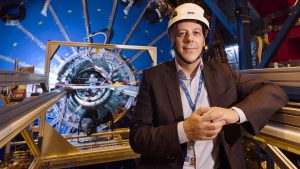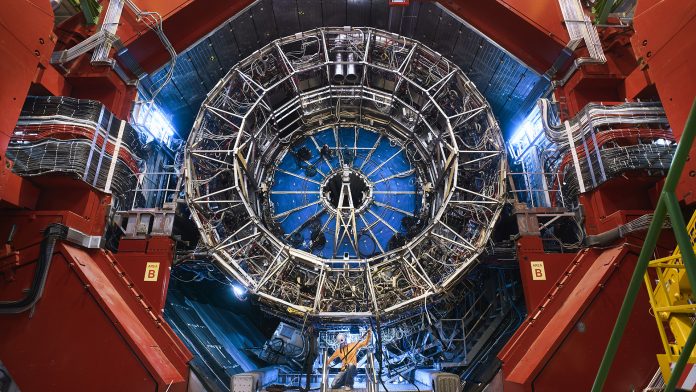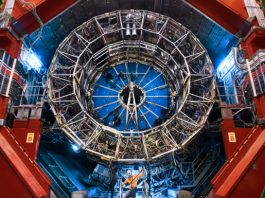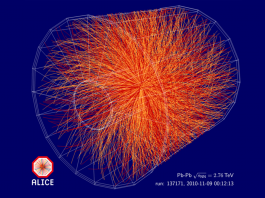Luciano Musa, Spokesperson for the ALICE Collaboration at CERN, outlines the upgrades made to the ALICE detector during the LHC’s Long Shutdown period and explains the hopes for ALICE during Run 3 of the LHC.
Designed to study the physics of strongly interacting matter at extreme energy densities, ALICE (A Large Ion Collider Experiment) is a detector dedicated to heavy-ion physics at CERN’s Large Hadron Collider (LHC). The ALICE collaboration uses the 10,000-tonne ALICE detector – 26m long, 16m high, and 16m wide – to study quark-gluon plasma (QGP). The detector sits in a vast cavern 56m below ground close to the village of St Genis-Pouilly in France, receiving beams from the LHC.
During the latest Long Shutdown period (LS2) of the LHC, the ALICE collaboration completed major upgrades of the detector with two main objectives: to increase the data-taking rate by around two orders of magnitude, and to enhance its track reconstruction efficiency and precision for the detection of short-lived particles containing heavy-flavour quarks. With this, ALICE expects to continue its scientific journey at the LHC for many years to come.
On 5 July 2022, the LHC started its latest data-taking period, Run 3, for its experiments. To find out what Run 3 holds for ALICE, The Innovation Platform spoke to Luciano Musa, Spokesperson for the ALICE collaboration at CERN.
What does Run 3 of the LHC mean for the ALICE experiment?
Run 3 represents a significant step towards larger amounts of recorded data with enhanced detectors, meaning higher precision measurements. First, thanks to the upgrade of the LHC, the sample of Pb-Pb collisions that ALICE will be able to inspect in Runs 3 and 4 is larger by a factor of about 10 compared to the sample collected in Runs 1 and 2. Actually, for most of the measurements, the gain is much larger and this is thanks to a massive upgrade of the ALICE detectors and readout systems that allow for a continuous readout and recording of all collisions. The other important change of ALICE is its efficiency and precision in the reconstruction of the trajectories of electrically charged particles and in the determination of the point in space where they are generated (‘impact parameter’), which are significantly enhanced in Run 3, especially for particles with low energy. In Run 3, thanks to the much larger data sample and improved detector precision, we expect to be moving from a phase where we observed many interesting properties of the quark-gluon plasma to a phase in which we precisely quantify these properties and connect them to the dynamics of its constituents.
ALICE underwent large improvements during the latest shutdown period of the LHC. Were any major issues encountered during this and, if so, how were they overcome?
The massive upgrade of the ALICE experimental apparatus, completed during the second LHC Long Shutdown (LS2), was obtained through the development of novel detector technologies and techniques, as well as by using the most advanced hardware and software technologies for the readout and online computing system. Such a programme called for a very broad and challenging R&D phase, full of technical difficulties, which was completed on schedule, with essentially all new and upgraded detector components ready for commissioning by early spring 2020.
The main challenge was the COVID-19 pandemic, which brought almost all hardware activities to a halt in March 2020 for a period of about three months. As from the beginning of June 2020, the ALICE activities at the CERN sites and in the ALICE cavern were progressively resumed, however, the quarantine and travel restrictions for ALICE collaboration members continued to have a strong impact on the progress for the whole of 2020 and part of 2021. This required a significant reorganisation of the activities to transfer most of the critical activities to the collaborators stationed in the CERN region, in order to complete the ALICE installation. In those difficult times, the ALICE collaboration has proven to cope with them with vitality and dedication and, eventually, in July 2021 the ALICE installation was successfully completed, concluding many years of intense work on R&D, construction, assembly and detector commissioning on surface. A following four-month period of global commissioning allowed us to complete the preparation of the experiment well before the cavern closure, in March 2022.

It is hoped that ALICE will record 50 times as many collisions as before. How will this be achieved and why is it such a significant development?
In Run 1 and 2, we could fully readout only about 10% of the collision events, selected based on a quick partial inspection of their information, generating a signal to trigger the readout of the full event. Thanks to a massive upgrade of the ALICE detector and its readout system, in Run 3 we will be able to readout continuously the full detector information for each individual Pb-Pb collision, without the need for any trigger. For most of the measurements planned for Run 3, this represents an increase of the event sample by a factor of 50, which is clearly a big deal.
The increase of the rate capabilities required a major and highly non-trivial upgrade of the Time Projection Chamber (TPC), which has been turned into the first TPC with continuous readout in a high-rate experiment, with an unprecedented data throughput of about 30 terabits per second. It also required new readout electronics to support continuous readout for all detectors and a new integrated online/offline compute farm, largely based on graphics processing units (GPUs), to perform the event reconstruction and data compression and selection online.
It is not only about increasing the number of collisions, we have also significantly enhanced the precision of our detector, for instance, in the measurement of the trajectories of electrically charged particles and in the determination of their impact parameter. This is achieved thanks to a new silicon pixel detector – the biggest ever built for a high-energy physics experiment, located very close to the collision point. This new detector, which is based on novel CMOS Monolithic Active Pixel Sensors (CMOS MAPS) used for the first time at the LHC, is a gigantic 3D camera with unprecedented granularity and precision. It consists of 13 billion pixels, each measuring the coordinates of particles with a precision better than 5 micrometers, and with an angular coverage which is significantly larger than the one of the detector used in Run 1 and 2.
How soon do you think it will be before progress is seen within the experiment?
To make significant progress with respect to the results achieved in the first two LHC Runs, the data sample of proton-proton, proton-lead and lead-lead collisions for the full Run 3 will have to be processed and analysed, which will take until 2026. It should also be stressed that, for some of the measurements, a better performance will be obtained by running the ALICE solenoid magnet at a lower field intensity, which will require dedicated run periods. Moreover, in Run 4 the total amount of data collected by ALICE will double, such that results with further precision will become available at the beginning of the next decade. Of course, results based on partial statistics will be published throughout the Run 3 and 4 periods, progressively increasing the number and quality of the individual tiles that form the mosaic picture we are developing to describe the QGP.
What is the ideal scenario for the ALICE experiment in Run 3?
Thanks to the results from the experiments at the Relativistic Heavy Ion Collider (RHIC) and from the first two Runs at the LHC, we made huge progress in the understanding of the QGP created in ultra-relativistic collisions of heavy nuclei. We know that it behaves as an expanding medium with high-density and low viscosity, whose constituents – quarks and gluons – are strongly coupled (their mean free path is much smaller than the QGP), which can be described with relativistic hydrodynamic models. As the QGP cools down, quarks and gluons quickly recombine, producing final state particles which flow together in a collective motion.
In Run 3 and 4, the focus will shift towards high-precision measurements, which on one hand will allow us to determine the macroscopic properties of the QGP – such as its temperature, energy density, shear and bulk viscosities and transport coefficients – while on the other hand, we will try to understand how these macroscopic properties are connected to the dynamics of its constituents in a microscopic description.
This will be possible in Run 3 through high-precision measurements of many different observables. Particularly important will be the measurement of hadrons containing charm or beauty quarks, which can probe the QGP at very small scales, enlightening its internal structure and dynamical properties. Another important part of the programme is the measurement of real and virtual photons, which are uniquely penetrating probes, as they do not interact with the QGP, and provide direct fundamental characteristics of the plasma, such as its temperature and phase transition.
There is much more. For example, understanding the emergence of high-density QCD effects (QGP-like signatures) in high multiplicity proton-proton and proton-lead collisions. This was one important and unexpected outcome of the LHC in Run 1 and 2, raising key questions which are hotly discussed at present. The study of high-multiplicity proton-proton and proton-nucleus collisions with much higher statistics, as well as the study of the collision of lighter ions, as oxygen, which is also planned in Run 3, will hopefully allow to shed light on these phenomena and develop a unified picture of QCD particle production from small to large systems.
There are much more ALICE plans for Run 3, also outside the domain of QGP studies with heavy-ion collisions. One important example is the measurement of the strong interaction between hadrons, which ALICE started in Run 2 and will continue in Run 3 with much higher precision and extending the measurements to hadrons that contain charm quarks.
Luciano Musa
ALICE Spokesperson
CERN
www.home.cern
https://www.linkedin.com/company/cern/
https://www.facebook.com/cern
https://twitter.com/CERN
Please note, this article will also appear in the eleventh edition of our quarterly publication.





